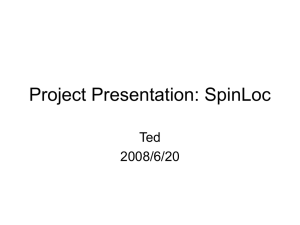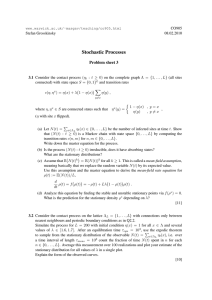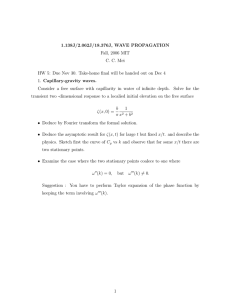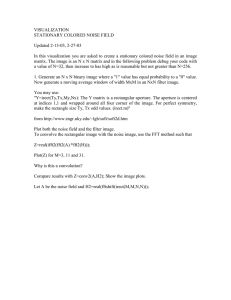3406e SOUND LEVEL LIMITS FOR STATIONARY SOURCES IN
advertisement
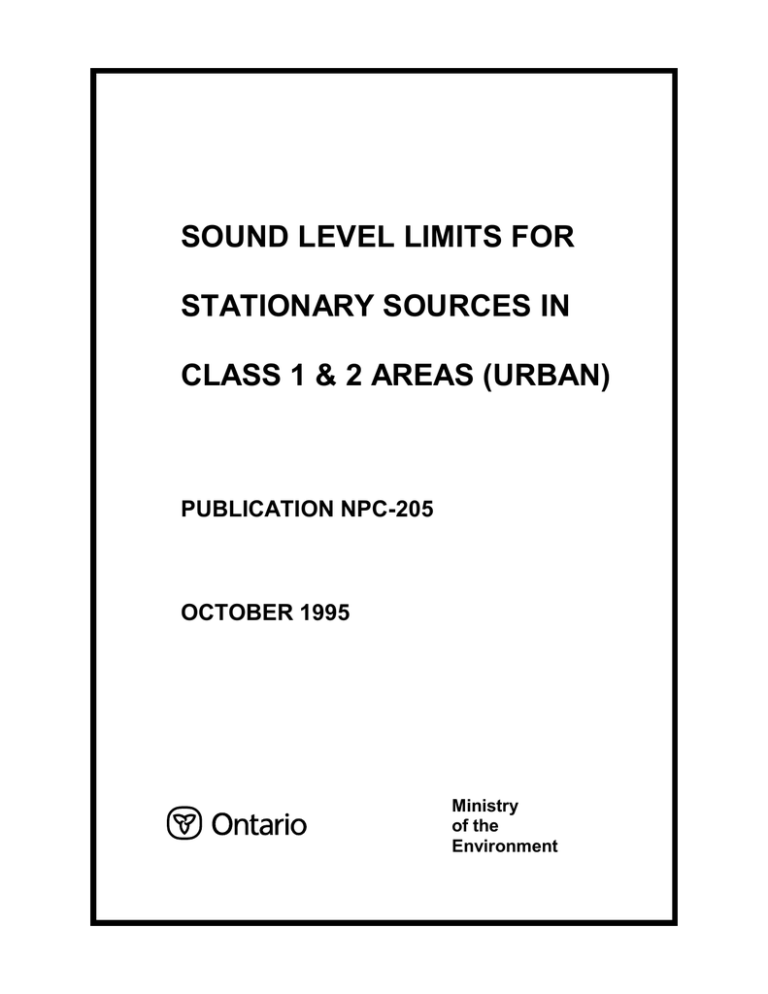
SOUND LEVEL LIMITS FOR STATIONARY SOURCES IN CLASS 1 & 2 AREAS (URBAN) PUBLICATION NPC-205 OCTOBER 1995 Ministry of the Environment Cette publication technique n`est disponible qu`en anglais. Copyright: Queen's Printer for Ontario, 1995 This publication may be reproduced for non­ commercial purposes with appropriate attribution. ISBN 0-7778-4922-4 PIBS 3406E Ontario MINISTRY OF THE ENVIRONMENT Sound Level Limits for Stationary Sources in Class 1 & 2 Areas (Urban) Publication NPC-205 October 1995 This Publication establishes sound level limits for stationary sources such as industrial and commercial establishments or ancillary transportation facilities, affecting points of reception in Class 1 and 2 Areas (Urban). It replaces Publication NPC-105 "Stationary Sources" of the "Model Municipal Noise Control By-Law, Final Report, August 1978". TABLE OF CONTENTS 1. 1. SCOPE . . . . . . . . . . . . . . . . . . . . . . . . . . . . . . . . . . . . . . . . . . . . . . . . . . . . - 1 ­ 2. REFERENCES . . . . . . . . . . . . . . . . . . . . . . . . . . . . . . . . . . . . . . . . . . . . . . - 2 ­ 3. TECHNICAL DEFINITIONS . . . . . . . . . . . . . . . . . . . . . . . . . . . . . . . . . . . . - 2 ­ 4. ESTABLISHMENT OF LIMITS - OBJECTIVE . . . . . . . . . . . . . . . . . . . . . . . - 3 ­ 5. BACKGROUND SOUND LEVELS . . . . . . . . . . . . . . . . . . . . . . . . . . . . . . . - 3 ­ 6. SOUND LEVELS DUE TO STATIONARY SOURCES . . . . . . . . . . . . . . . . - 3 ­ (1) Complaint Investigation of Stationary Sources . . . . . . . . . . . . . . . . - 3 ­ (2) Approval of Stationary Sources . . . . . . . . . . . . . . . . . . . . . . . . . . . - 3 ­ 7. PROCEDURES . . . . . . . . . . . . . . . . . . . . . . . . . . . . . . . . . . . . . . . . . . . . . - 4 ­ 8. SOUND LEVEL LIMITS - GENERAL . . . . . . . . . . . . . . . . . . . . . . . . . . . . . - 4 ­ 9. SOUND LEVEL LIMITS - SPECIFIC IMPULSIVE SOUNDS . . . . . . . . . . . . - 4 ­ 10. SOUND LEVEL LIMITS - PEST CONTROL DEVICES . . . . . . . . . . . . . . . . - 4 ­ 11. PROHIBITION - PEST CONTROL DEVICES . . . . . . . . . . . . . . . . . . . . . . . - 5 ­ 12. PRE-EMPTION . . . . . . . . . . . . . . . . . . . . . . . . . . . . . . . . . . . . . . . . . . . . . . - 5 ­ 13. EXCLUSION . . . . . . . . . . . . . . . . . . . . . . . . . . . . . . . . . . . . . . . . . . . . . . . . - 5 - A.1. GENERAL . . . . . . . . . . . . . . . . . . . . . . . . . . . . . . . . . . . . . . . . . . . . . . . - A 1 - A.2. APPLICATION . . . . . . . . . . . . . . . . . . . . . . . . . . . . . . . . . . . . . . . . . . . . - A 1 - A.3. STATIONARY SOURCES . . . . . . . . . . . . . . . . . . . . . . . . . . . . . . . . . . . - A 1 ­ (1) Included Sources . . . . . . . . . . . . . . . . . . . . . . . . . . . . . . . . . . . . - A 1 ­ (2) Excluded Sources . . . . . . . . . . . . . . . . . . . . . . . . . . . . . . . . . . . - A 2 - A.4. PREDICTABLE WORST CASE IMPACT . . . . . . . . . . . . . . . . . . . . . . . . - A 2 - A.5. DEFINITIONS . . . . . . . . . . . . . . . . . . . . . . . . . . . . . . . . . . . . . . . . . . . . . - A 3 ­ SCOPE This Publication establishes sound level limits for stationary sources such as industrial and commercial establishments or ancillary transportation facilities, affecting points of reception in Class 1 and 2 Areas (Urban). The limits apply to noise complaint investigations carried out in order to determine potential violation of Section 14 of the Environmental Protection Act. The limits also apply to the assessment of planned stationary sources of sound in compliance with Section 9 of the Environmental Protection Act, and under the provisions of the Aggregate Resources Act and the Environmental Assessment Act. Ontario MINISTRY OF THE ENVIRONMENT This Publication does not address sound and vibration produced by blasting; blasting in quarries and surface mines is considered in Reference [7]. The Publication includes an Annex, which provides additional details, definitions and rationale for the sound level limits. 2. REFERENCES Reference is made to the following publications: [1] NPC-101 - Technical Definitions [2] NPC-102 - Instrumentation [3] NPC-103 - Procedures [4] NPC-104 - Sound Level Adjustments [6] NPC-206 - Sound Levels due to Road Traffic [7] NPC-119 - Blasting [8] NPC-216 - Residential Air Conditioning Devices [9] NPC-232 - Sound Level Limits for Stationary Sources in Class 3 Areas (Rural) [10] NPC-233 - Information to be Submitted for Approval of Stationary Sources of Sound [12] ORNAMENT, Ontario Road Noise Analysis Method for Environment and Transportation, Technical Document, Ontario Ministry of the Environment, ISBN 0-7729-6376, 1989 References [1] to [4] and [7] can be found in the Model Municipal Noise Control By-Law, Ontario Ministry of the Environment, Final Report, August 1978. 3. TECHNICAL DEFINITIONS "Ambient sound level" means Background sound level. "Background sound level" is the sound level that is present in the environment, produced by noise sources other than the source under impact assessment. Highly intrusive short duration noise caused by a source such as an aircraft fly-over or a train pass-by is excluded from the determination of the background sound level. "Class 1 Area" means an area with an acoustical environment typical of a major population centre, where the background noise is dominated by the urban hum. Publication NPC-205 -2- October 1995 Ontario MINISTRY OF THE ENVIRONMENT "Class 2 Area" means an area with an acoustical environment that has qualities representative of both Class 1 and Class 3 Areas, and in which a low ambient sound level, normally occurring only between 23:00 and 07:00 hours in Class 1 Areas, will typically be realized as early as 19:00 hours. Other characteristics which may indicate the presence of a Class 2 Area include: � � � absence of urban hum between 19:00 and 23:00 hours; evening background sound level defined by natural environment and infrequent human activity; and no clearly audible sound from stationary sources other than from those under impact assessment. "Class 3 Area" means a rural area with an acoustical environment that is dominated by natural sounds having little or no road traffic, such as the following: � � � � a small community with less than 1000 population; agricultural area; a rural recreational area such as a cottage or a resort area; or a wilderness area. Other technical terms are defined in Reference [1] and in the Annex to Publication NPC-205. 4. ESTABLISHMENT OF LIMITS - OBJECTIVE The sound level limit at a point of reception must be established based on the principle of "predictable worst case" noise impact. In general, the limit is given by the background sound level at the point of reception. The sound level limit must represent the minimum background sound level that occurs or is likely to occur during the operation of the stationary source under impact assessment. 5. BACKGROUND SOUND LEVELS The time interval between the background sound level measurement and the measurement of the sound level produced by the stationary source under impact assessment should be minimized as much as possible. Preferably, the two measurements should be carried out within one hour of each other. 6. SOUND LEVELS DUE TO STATIONARY SOURCES (1) Complaint Investigation of Stationary Sources The One Hour Equivalent Sound Level (Leq) and/or the Logarithmic Mean Impulse Sound Level (LLM) produced by the stationary sources shall be obtained by measurement performed in accordance with Section 7. (2) Approval of Stationary Sources The One Hour Equivalent Sound Level (Leq) and/or the Logarithmic Mean Impulse Sound Level (LLM) produced by the stationary sources shall be obtained by measurement or prediction. The estimation of the Leq and/or LLM of the stationary source under impact assessment shall reflect the principle of "predictable worst case" noise impact. The "predictable worst case" noise impact occurs during the hour when the difference between the predicted sound level produced by the stationary source and the background sound level of the natural environment is at a maximum. Publication NPC-205 -3- October 1995 Ontario MINISTRY OF THE ENVIRONMENT 7. PROCEDURES All sound level measurements and calculations shall be made in accordance with References [3], [6]and [12]. Sound from existing adjacent stationary sources may be included in the determination of the background One Hour Equivalent Sound Level (Leq) if such stationary sources of sound are not under consideration for noise abatement by the Municipality or the Ministry of Environment and Energy. 8. 9. SOUND LEVEL LIMITS - GENERAL (1) For impulsive sound, other than Quasi-Steady Impulsive Sound, from a stationary source, the sound level limit expressed in terms of the Logarithmic Mean Impulse Sound Level (LLM) is the background One Hour Equivalent Sound Level (Leq) typically caused by road traffic as obtained pursuant to Section 6 for that point of reception. (2) For sound from a stationary source, including Quasi-Steady Impulsive Sound but not including other impulsive sound, the sound level limit expressed in terms of the One Hour Equivalent Sound Level (Leq) is the background One Hour Equivalent Sound Level (Leq) typically caused by road traffic as obtained pursuant to Section 6 for that point of reception. SOUND LEVEL LIMITS - SPECIFIC IMPULSIVE SOUNDS (1) For impulsive sound, other than Quasi-Steady Impulsive Sound, from a stationary source which is an industrial metal working operation (including but not limited to forging, hammering, punching, stamping, cutting, forming and moulding), the sound level limit at a point of reception expressed in terms of the Logarithmic Mean Impulse Sound Level (LLM) is 60 dBAI, if the stationary source were operating before January 1, 1980, and otherwise is 50 dBAI. (2) For impulsive sound, other than Quasi-Steady Impulsive Sound, from a stationary source which is the discharge of firearms on the premises of a licensed gun club, the sound level limit at a point of reception expressed in terms of the Logarithmic Mean Impulse Sound Level (LLM) is: � � � (3) 10. 70 dBAI if the gun club were operating before January 1, 1980; or 50 dBAI if the gun club began to operate after January 1, 1980; or the LLM prior to expansion, alteration or conversion. For impulsive sound, other than Quasi-Steady Impulsive Sound, from a stationary source which is not a blasting operation in a surface mine or quarry, characterized by impulses which are so infrequent that they cannot normally be measured using the procedure for frequent impulses of Reference [3] the sound level limit at a point of reception expressed in terms of the impulse sound level is 100 dBAI. SOUND LEVEL LIMITS - PEST CONTROL DEVICES (1) For impulsive sound, other than Quasi-Steady Impulsive Sound, from a pest control device employed solely to protect growing crops, the sound level limit at a point of reception expressed in terms of the Logarithmic Mean Impulse Sound Level (LLM) is 70 dBAI. (2) For sound, including Quasi-Steady Impulsive Sound but not including other impulsive sound, from a pest control device employed solely to protect growing crops, the sound level limit at a point of reception expressed in terms of the One Hour Equivalent Sound Level (Leq) is 60 dBA. Publication NPC-205 -4- October 1995 Ontario MINISTRY OF THE ENVIRONMENT 11. PROHIBITION - PEST CONTROL DEVICES The operation of a pest control device employed solely to protect growing crops outdoors during the hours of darkness, sunset to sunrise, is prohibited. 12. PRE-EMPTION The least restrictive sound level limit of Sections 8, 9 and 10 applies. 13. EXCLUSION No restrictions apply to a stationary source resulting in a One Hour Equivalent Sound Level (Leq) or a Logarithmic Mean Impulse Sound Level (LLM) lower than the minimum values for that time period specified in Table 205-1. TABLE 205-1 Minimum Values of One Hour Leq or LLM by Time of Day One Hour Leq (dBA) or LLM (dBAI) Time of Day Class 1 Area Class 2 Area 0700 - 1900 50 50 1900 - 2300 47 45 2300 - 0700 45 45 May 21, 1999 Publication NPC-205 -5- October 1995 Ontario MINISTRY OF THE ENVIRONMENT Publication NPC-205 -6- October 1995 Ontario MINISTRY OF THE ENVIRONMENT Annex to Publication NPC-205 Sound Level Limits for Stationary Sources in Class 1 & 2 Areas (Urban) October 1995 A.1. GENERAL In general, noises are annoying because they are heard over and above the level of the so-called "background" or surrounding environmental noise climate at a particular location. The standard for environmental noise acceptability of stationary sources is therefore expressed as the difference between noise from the source and the background noise. The background noise is essentially made up of the road traffic noise which creates an "urban hum". It may also include contributions from existing industry or commercial activity adjacent to the stationary source under investigation. Contributions of these secondary noise sources are considered to be a part of urban hum and may be included in the measurements or calculation of the background sound levels, provided that they are not under consideration for noise abatement by the Municipality or the Ministry of Environment and Energy. The sound level limits specified in Section 8 of Publication NPC-205 represent the general limitation on noise produced by stationary sources. Some noises, however, are annoying no matter where or in what kind of environment they exist. High level impulsive noises represent a special category and, consequently, are restricted by an absolute limitation. Sections 9 and 10 of this Publication provide criteria of acceptability for specific impulsive noise sources. A.2. APPLICATION The limits presented in Publication NPC-205 are designed for the control of noise from sources located in industrial, commercial or residential areas. The limits apply to points of reception located in Class 1 and Class 2 Areas. Sound level limits contained in Publication NPC-205 do not apply to the excluded noise sources listed in Section A.3.(2) and neither do they apply to any equipment, apparatus or device used in agriculture for food crop seeding, chemical spraying or harvesting. In addition, several specific noise sources have been addressed in separate Publications. Limits for residential air conditioners are contained in Publication NPC-216 - Residential Air Conditioning Devices, Reference [8] and the limits for blasting operations in quarries and surface mines are contained in Publication NPC-119 - Blasting, Reference [7]. A.3. STATIONARY SOURCES The objective of the definition of a stationary source of sound is to address sources such as industrial and commercial establishments or ancillary transportation facilities. In order to further clarify the scope of the definition, the following list identifies examples of installations, equipment, activities or facilities that are included and those that are excluded as stationary sources. (1) Included Sources Individual stationary sources such as: Heating, ventilating and air conditioning (HVAC) equipment; Rotating machinery; Impacting mechanical sources; Generators; Burners; Grain dryers. Ontario MINISTRY OF THE ENVIRONMENT Facilities, usually comprising many sources of sound. In this case, the stationary source is understood to encompass all the activities taking place within the property boundary of the facility. The following are examples of such facilities: Industrial facilities; Commercial facilities; Ancillary transportation facilities; Aggregate extraction facilities; Warehousing facilities; Maintenance and repair facilities; Snow disposal sites; Routine loading and unloading facilities (supermarkets, assembly plants, etc.). Other sources such as: Car washes; Race tracks; Firearm Ranges. (2) Excluded Sources Secific sources or facilities: Construction activities; Transportation corridors, i.e. roadways and railways; Residential air conditioning devices including air conditioners and heat pumps; Gas stations; Auditory warning devices required or authorized by law or in accordance with good safety practices; Occasional movement of vehicles on the property such as infrequent delivery of goods to convenience stores, fast food restaurants, etc. Other noise sources, normally addressed in a qualitative manner in municipal noise by-laws: The operation of auditory signalling devices, including but not limited to the ringing of bells or gongs and the blowing of horns or sirens or whistles, or the production, reproduction or amplification of any similar sounds by electronic means; Noise produced by animals kept as domestic pets such as dogs barking; Tools and devices used by occupants for domestic purposes such as domestic power tools, radios and televisions, etc., or activities associated with domestic situations such as domestic quarrels, noisy parties, etc; Noise resulting from gathering of people at facilities such as restaurants and parks. Activities related to essential service and maintenance of public facilities such as but not limited to roadways, parks and sewers, including snow removal, road cleaning, road repair and maintenance, lawn mowing and maintenance, sewage removal, garbage collection, etc. A.4. PREDICTABLE WORST CASE IMPACT The assessment of noise impact requires the determination of the "predictable worst case" impact. The "predictable worst case" impact assessment should establish the largest noise excess produced by the source over the applicable limit. The assessment should reflect a planned and predictable mode of operation of the stationary source. It is important to emphasize that the "predictable worst case" impact does not necessarily mean that the sound level of the source is highest; it means that the excess over the limit is largest. For example, the excess over the applicable limit at night may be larger even if the day-time sound level produced by the source is higher. Annex to Publication NPC-205 -A2- October 1995 Ontario MINISTRY OF THE ENVIRONMENT A.5. DEFINITIONS In the interpretation of Publication NPC-205, the following definitions are of particular relevance: - Ancillary Transportation Facilities "Ancillary transportation facilities" mean subsidiary locations where operations and activities associated with the housing of transportation equipment (or personnel) take place. Examples of ancillary transportation facilities include, but are not limited to, substations, vehicle storage and maintenance facilities, fans, fan and vent shafts, mechanical equipment plants, emergency services buildings, etc; - Construction "Construction" includes erection, alteration, repair, dismantling, demolition, structural maintenance, painting, moving, land clearing, earth moving, grading, excavating, the laying of pipe and conduit whether above or below ground level, street and highway building, concreting, equipment installation and alteration and the structural installation of construction components and materials in any form or for any purpose, and includes any work in connection therewith; "construction" excludes activities associated with the operation at waste and snow disposal sites; - Construction Equipment "Construction equipment" means any equipment or device designed and intended for use in construction, or material handling including but not limited to, air compressors, pile drivers, pneumatic or hydraulic tools, bulldozers, tractors, excavators, trenchers, cranes, derricks, loaders, scrapers, pavers, generators, off-highway haulers or trucks, ditchers, compactors and rollers, pumps, concrete mixers, graders, or other material handling equipment; - Conveyance "Conveyance" includes a vehicle and any other device employed to transport a person or persons or goods from place to place but does not include any such device or vehicle if operated only within the premises of a person; - Highway "Highway" includes a common and public highway, street, avenue, parkway, driveway, square, place, bridge, viaduct or trestle designed and intended for, or used by, the general public for the passage of vehicles; - Motor Vehicle "Motor vehicle" includes an automobile, motorcycle,and any other vehicle propelled or driven otherwise than by muscular power, but does not include the cars of diesel, electric or steam railways, or other motor vehicles running only upon rails, or a motorized snow vehicle, traction engine, farm tractor, self-propelled implement of husbandry or road-building machine within the meaning of the Highway Traffic Act; - Motorized Conveyance "Motorized conveyance" means a conveyance propelled or driven otherwise than by muscular, gravitational or wind power; - Noise "Noise" means unwanted sound; - Point of Reception "Point of reception" means any point on the premises of a person where sound or vibration originating from other than those premises is received. Annex to Publication NPC-205 -A3- October 1995 Ontario MINISTRY OF THE ENVIRONMENT For the purpose of approval of new sources, including verifying compliance with Section 9 of the Environmental Protection Act, the point of reception may be located on any of the following existing or zoned for future use premises: permanent or seasonal residences, hotels/motels, nursing/retirement homes, rental residences, hospitals, camp grounds, and noise sensitive buildings such as schools and places of worship. For equipment/facilities proposed on premises such as nursing/retirement homes, rental residences, hospitals, and schools, the point of reception may be located on the same premises; - Stationary Source "Stationary source" means a source of sound which does not normally move from place to place and includes the premises of a person as one stationary source, unless the dominant source of sound on those premises is construction or a conveyance; - Urban Hum means aggregate sound of many unidentifiable, mostly road traffic related noise sources. ISBN 0-7778-4922-4 PIBS 3406E May 21, 1999 Annex to Publication NPC-205 -A4- October 1995



